If the water froze in the heating system, the life of all the inhabitants of the house or apartments turns into hell. The air temperature is falling rapidly, utilities are bravely holding the defense and claim that there were no signals of an accident, and attempts to go down to the basement and find out the state of the pipe end in failure
If the heating system in a private house is frozen, the external manifestations of the problem may be completely different, and they are not always so deplorable. At least, if the pipe does not burst, but is simply clogged with an ice plug or leaks a little. In this case, it is possible to cope with the disaster without critical consequences for the budget, but, alas, this is not always the case.
How to defrost the heating system in a house without bringing the situation to a critical one? What are the main causes of icing on the contour and is it possible to cope with them without great losses? Is it realistic to prevent the problem? Let's try to find answers to all these questions together.
Water frozen in a plastic pipe - what to do and how to fix the problem?
Winter prepares unexpected surprises for all of us, sometimes not very pleasant ones. When it comes to communication systems, their failure can turn out to be very deplorable. When it comes to metal communications, then their freezing can be predicted. Another thing is metal-plastic pipes, which are more resistant to frost. However, such pipelines often freeze.
We often hear from residents of private houses such words: water in a plastic pipe has frozen - what to do? It becomes especially offensive when there is no supply of drinking water in the house. Therefore, every home owner needs to know what to do in case of freezing of a plastic water pipe.
Often, the reasons for this phenomenon lie in the initially incorrect laying of communications. All waterways, regardless of the material, should be located at such a depth that does not freeze even in a very harsh winter.
If it is not possible to dig a trench deeply, then it is necessary to reliably wrap the pipes with heat-insulating and moisture-resistant materials. So what to do if the water supply is still frozen? Consider two cases when the water supply system is frozen inside and outside the house.
About frost prevention
A very important aspect is the choice of pipes for the building's heating system. The weakest point of all pipes is corrosive processes. The most durable material is cast iron, according to the manufacturers of cast iron batteries, they can last up to 100 years. The least resistant is aluminum, which has a service life of about 10 years. Steel batteries will last you 25 years. Plastic pipes are not susceptible to corrosion, scale is not deposited in them, they will last 50 years.
In addition, such pipes will not burst if defrosting of the heating system is required - in that place, only a slight swelling will be visible.
The owner of the house must be personally present at the time when the heating system of a private house will be launched. First of all, you need to pay attention to the welded joints, as well as how the pipes are laid in the trenches. Before backfilling them, you need to make sure that the pipe insulation is in the "backfill" of gravel.
Otherwise, deformation or even rupture may occur. It is also necessary to check how reliably the sealing of the threaded joints of heating systems is carried out in areas where there is no mandatory use of welding.

How to defrost a plastic pipe indoors?
When we say that plastic pipes are frozen inside the building, it means that there is free access to them.For example, they can be located in the attic or in the basement, that is, in places where there is no heating.
In this case, the defrosting process can be performed in several ways:
- Using hot water The frozen area is wrapped with a cloth and poured over with hot water. The operating time depends on the length of the ice plug. The defrosted pipe must be covered with insulation to prevent its re-freezing.
The place of freezing is determined by touch. Where the plastic pipe is colder, there is an ice plug.
- With the help of a construction hot air gun. A jet of warm air is directed from the hair dryer to the surface of the pipe. Despite the high efficiency of this method, such work is considered dangerous. If the air is too hot, the PVC may simply melt. Therefore, the temperature of the hair dryer must be set to a minimum.
- Using electrical heating. The metal-plastic pipe is wrapped with an electric heating wire, which is connected to the mains. The wire is wound in turns. In the presence of a small frozen area, defrosting occurs quickly enough. Warming up a plastic water pipe takes up to 3 hours.
Attention! During the defrosting process, the water taps must be open, since the melted water must flow freely from the pipeline.
If communications freeze underground?
The situation is much more complicated if a metal-plastic pipe is frozen underground. The easiest way is to dig a trench that will not be very deep. After that, apply one of the methods used for defrosting indoor pipelines. However, in practice, this option is usually unacceptable due to the fact that it is very difficult to dig frozen ground, and the plastic pipe can be accidentally damaged. Therefore, we will consider alternative options.
Defrosting plastic water pipes with hot water
The heated water should be supplied to the inside of the pipe, directly to the ice plug. To do this, you need to disconnect the plastic pipe from the taps. Further work is carried out in the following order. Water is heated in an iron barrel. This can be done over a fire or heated in the house. A smaller diameter pipe or hose is inserted into the plastic pipe. The end of the hose should rest against the ice seal.
After that, you need to supply hot water from the barrel to the hose. This can be done using a pressure pump. Hot water will melt the ice quickly enough. The hose must be pushed forward through the pipe as the ice thaws.
When the whole plug has melted, water will pour out of the pipe with a strong pressure. Then the pump can be turned off. Heating a metal-plastic pipe in this way takes a little time. Preparation for the defrosting process takes much longer.
Tip: open areas of a plastic pipe must be covered with insulation to avoid re-freezing.
Defrosting with electricity
To do this, you need to take a rigid two-core wire and subject it to some refinement. One core of the wire is separated from the other and freed from the insulation. After that, the bare wire is rolled up into a twist. The second wire is folded back and also stripped of insulation. Twisting the wire is done in the same way. As a result of this operation, you should get a wire with two bare twists, located a couple of centimeters from each other.
Attention! During operation, the wires should not touch each other, therefore, the twists should be made very strong, not allowing the wire to unwind. Touching wires can result in electric shock.
The prepared wire is wound inside the pipe to the very ice obstacle, after which it is connected to the network. Heating of water and ice occurs due to the potential difference across the twists.In this case, the walls of the plastic pipe do not melt, since only the inner contents of the pipe are heated. As it defrosts, the wire must be pushed further down the pipe.
The disadvantage of this method is the need to pump out melt water from the pipeline. If it is not pumped out, it may freeze again. A compressor or pump can be used for evacuation.
You can also mention a few more ways to defrost plastic pipes, which are not available to every home owner.
In fairness, we list them:
- use of a steam generator. The steam generator hose is pushed inward through the pipe and steam is released under pressure. Since the steam temperature is higher than that of boiling water, the defrosting process is very efficient. If the plastic pipe is frozen, and you have a steam generator, then you do not need to worry about the pipes. The disadvantage of this method is that not everyone has a similar unit;
- defrosting by means of an autoclave. Hot steam is also used here. It is necessary to heat the water in the autoclave, and push the hose into the pipe. Connect the other end of the hose to the autoclave. As the water boils, the generated steam will go through the hose to the pipe and will melt the ice. Instead of an autoclave, you can use another appliance, such as a steamer.
- warming up by a hydrodynamic machine. This is a special equipment used for industrial purposes. The device creates increased pressure in the pipe, which breaks the ice in literally minutes. A special hose is inserted into the pipe as far as possible. After that, the machine is put into operation. After a couple of minutes, there is no ice in the pipe.
We have examined all the main methods for defrosting plastic pipes. Which of these methods to use, decide for yourself. And next year, try to eliminate the problem of freezing pipes.
At what temperature does water freeze in heating pipes in a residential building
If the house has a temperature of -10 for several days, and there is water in the pipes, then it can freeze, which will lead to rupture of the pipes. Many have probably seen modern heating batteries with a water drain function. Almost all modern batteries are equipped with the ability to drain water. This is done so that in the event of an emergency, when the temperature in the house is -10, the water does not freeze and does not tear pipes. If the situation has come to this, we really sympathize with you, most likely you will have to change the batteries, since in the process of freezing the water, microcracks must have occurred, which make further operation of these batteries dangerous.
Why can water freeze in pipes. If during the heating season, just when the batteries are filled with water, a breakdown occurs and the water is supplied cooled, and the temperature drops rapidly outside, this can lead to freezing of pipes.
We have already answered the question at what temperature water freezes, as an experiment, take a small glass, fill it halfway with water and put it in the freezer for several hours, two hours are enough for the water to partially turn into ice.
Pure water -
It is considered the best liquid that perfectly cleanses and moisturizes the body. The human body is about 70% water.
If you are feeling tired, sleepy, or lethargic, it is recommended that you drink one glass of warm water. According to the results of the experiment, a person should drink about 30 ml of water per kilogram of body weight. Therefore, if your weight is 70 kg, then it is advised to consume 2.1 liters of water every day. To meet the body's fluid needs, it is recommended to drink at least 1.5 liters of water daily, you can drink half a glass of water every 40-50 minutes.
Water has many useful properties and life on Earth is impossible without it. Everyone knows that the water will freeze freezing point should be 0 degrees Celsius,
but this is in the case of normal natural conditions.
It is worth noting that the pressure in different parts of the globe is significantly different, therefore the freezing point of water depends on a certain pressure indicator.
It is important to understand the fact that the higher the pressure in the environment, the higher the freezing point, or vice versa, the lower the pressure in the natural environment, the lower the crystallization temperature.
Freezing point of water in oceans and seas
Remember to take into account the presence of molecules and impurities in the water. They greatly affect the freezing point of water. For example, salt water can freeze at very low temperatures (around -2 degrees Celsius).
If you take absolutely pure water, then it may not even freeze at a temperature of -70 degrees Celsius. Fish blood usually freezes at -1 ° C. Many scientists have wondered how fish manage to stay warm when temperatures are too low. It turns out that there are fish species that are capable of producing proteins in the pancreas. It is they that are absorbed by the blood and do not give the opportunity to start the crystallization process.
- Distilled water is an excellent dielectric and is almost incapable of conducting current.
- It expands when it freezes and evaporates.
- The only substance that manages to be in three states of aggregation at once.
- It is able to dissolve almost all substances on Earth.
- Glaciers contain about 2/3 of the world's total fresh water supply.
- It is generally accepted that the freezing point of fresh water is 0 degrees Celsius, and sea water freezes at a temperature of -1.8 ° C.
Instant freezing of water - video
Liquid purified by evaporation, cooling and condensation has special physical properties. It is recommended to use it in the heating system, since there are no salts and oxygen. This has a positive effect on the duration of the equipment functioning.
What to do when the water supply is frozen: 3 ways to defrost plastic pipes without digging
Plumbing needs to be laid wisely and done so that it functions smoothly all year round. But if mistakes were made during the installation, they will have to be corrected at the most inopportune moment. One of the worst consequences of poor plumbing is water freezing. Consider 3 proven methods for defrosting plastic pipes.
Winter, as always, comes unexpectedly! Let's imagine a situation - you wake up in the morning, there is a bitter frost outside the window, and water does not flow from the tap. An inner voice suggests that the pipe is frozen. What to do?
Often, the water supply system freezes underground, as well as in places of contact with the foundation and reinforced concrete structures. It is not possible to warm up the pipe outside in such places. Here you have to act remotely, inside a thin water conduit.
The principle of defrosting the water supply system is the supply of the coolant to the ice plug. This is very problematic to do. It is not enough to pour boiling water from a kettle inside - it will do nothing. The coolant must be supplied constantly, until the ice plug is completely thawed.
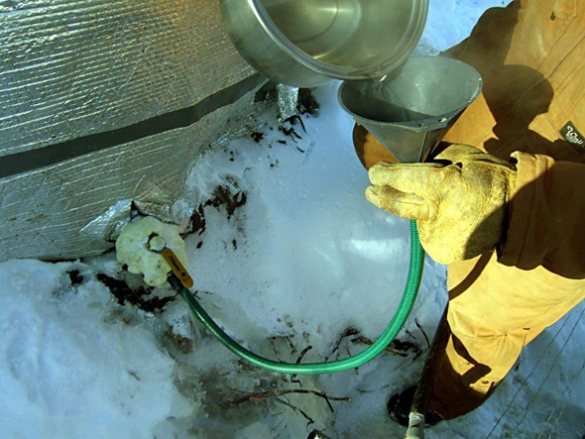

Where to start?
For those using the well, the first step is to make sure that the ice plug is in the pipe and not in the pump or outside tap.
This is done simply: the electric pump is disconnected from the water supply and turned on - water has gone, which means there is ice in the pipe. It happens that the faucet in the well freezes. Warm it up with a hairdryer. If there is no result, then the point is in the pipe and you need to choose a convenient way to fix the problem and start work.
It will be useful: Fighting spider mites in the greenhouse: measures to get rid of, treatment in the spring, means of prevention, destroy
Express Answers
At how many degrees does water freeze:
- In the heating pipes? If the heating is turned off or a heating boiler breaks down in a private house or in a country house, water freezing in them can occur in about a couple of days at a temperature of -5 degrees. Thermal insulation of pipes and other elements of the building will help to delay the onset of such an outcome. Inside a dwelling, water freezing in pipes occurs already at -1 degrees. If this temperature lasts for 2-3 days, it may end in rupture of pipes and heating batteries.
- Underground? Groundwater can be liquid, solid and vaporous. The solid phase of water in the soil is ice, which can be both perennial (in permafrost conditions) and seasonal. Freezing of soil water occurs at temperatures below zero, since all of them are not pure water, but all kinds of its solutions. The value of the freezing point largely depends on the salinity of groundwater.
- On the fly? The inhabitants of Yakutia have a simple way of determining the air temperature: it is below -42 degrees, if the spit released by a person manages to freeze before reaching the ground.
- In a vacuum? The contents of the test tube, placed under the bell of a vacuum pump at a temperature of 0 degrees, first boil, and after the evaporation of an eighth of the liquid, an ice crust forms on its surface.
- In a car engine? The maximum freezing temperature of water in the engine can reach -5 degrees: at lower values, ice crystals will simply rupture the internal structure of the engine block. The freezing point of water in the radiator is exactly the same. Similar problems in the car can arise under the condition of insufficient insulation of the above units, as well as due to too long parking.
- On the rink? Depending on what kind of competition is supposed to be held on the ice arena, the surface temperature of the ice can range from -3 to -5 degrees. Ice with a higher surface temperature (from -3 to -4) is suitable for figure skating, since it is precisely its softness that provides the necessary grip on the skates. Harder ice, suitable for team hockey, is obtained at a temperature of -5 degrees. On “cold” ice, the players' speed increases and the possibility of snow “mush” formation on its surface decreases. The quality of ice primarily depends on the chemical composition of the water, therefore, not ordinary tap liquid is used to fill it, but either purified or treated with special conditioners water.
And now, negative temperatures began. Today in the morning they promise to -3, and now the thermometer is 0.
Snow fell, and there was a threat of freezing water in the garden plumbing:
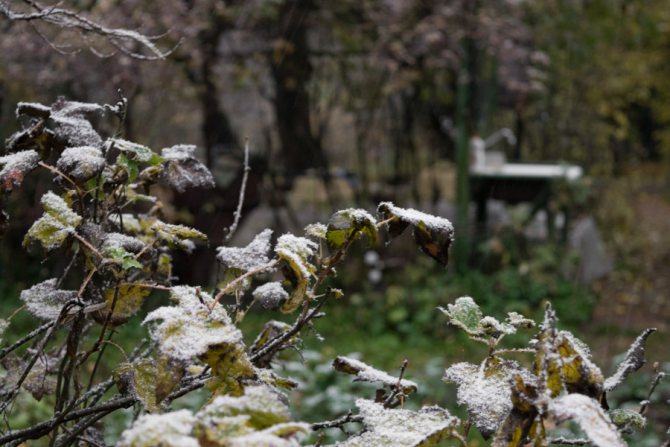

Compost pile and trees in the snow:


Spruce branches and electric wires in the snow:


Everyone is draining water from summer water pipes. I have not yet merged, and for that I have two reasons - incentive and reasonable. Incentive - I don't want to use a cold washstand for several days before the planned departure to the city. And a reasonable reason explains why you really don't need to.
To begin with, I live at the dacha only in the warm season, when the air temperatures are extremely positive. Although my house is insulated, due to its thermal insulation characteristics it is not intended for winter living. Yes, it is insulated with layers of foam and foil insulation, but this insulation is not enough for significant temperature minuses. Therefore, I did not particularly bother with the plumbing. A submersible pump in a well pumps water into a hydraulic accumulator located in an unheated utility block through a HDPE pipe with a diameter of 32 mm, and distribution to eight points on the site goes through HDPE pipes with a diameter of 25 mm. The pipes, where they do not interfere, lie directly on the surface of the earth, and in other places they are simply slightly deepened into the ground.
From my school physics course, I know for sure that the point of transition of water from a liquid to a solid state is at 0 degrees. But something told me that the freezing point of water in the pipe would be slightly lower. I could not clearly explain the reason for this feeling, and I went to the Internet to find out exactly at what temperature the water in the pipes really freezes. And indeed, I found information that in order to freeze water in a pipe, temperatures of -5 - -7 degrees are needed, standing for several days! I don’t know how true this is, but it meant that at least one night at a temperature of -3 the water supply system should definitely withstand.
The fact that the black plastic HDPE pipe runs in the upper fertile layer of the earth, in which decay processes continue to occur with the inevitable release of heat, inspires me with additional optimism. And, finally, I do not particularly risk anything - the HDPE pipe endures a sufficient number of freeze-thaw cycles of water in it. The most that can happen is the fittings will weaken, but they can always be tightened. The accumulator is located even in an unheated, but closed room, which should also help protect it from a small minus. In general, I decided not to drain the water yet. Although the closed ball valves are disturbing, the ones on the street. Perhaps this is the only weak point. If they don't make it through the night, they'll have to think further. But an experiment is an experiment. Tomorrow I'll sign off on the results (if there is time in between spills of pipes with boiling water)))
Method one: defrost the pipe using a miniature boiler
If you decide to use these methods, then take security measures.
- When using a common water supply or well, warn nearest neighbors not to turn on the water while you are defrosting.
- Defrost from the top of the pipe. This is important, since melt water must not be allowed to drain under voltage - this is a guaranteed electric shock!
- Turn off the tap.
To make a boiler you will need:
- rigid two-core cable - 2 * 2.5–4.0 mm (copper, aluminum);
- plug;
- single-phase 10 amp circuit breaker;
- insulating tape.
The cable will fit both two-core and three-core - the third core is not required.
The machine is needed to avoid a short circuit and overheating of the wire - it will not be cost-effective to throw it out after the first use. And also the use of an automatic machine will not allow the house to be de-energized in the event of a short circuit. The 10 amp breaker is taken from the approximate capacity of the device - it does not exceed 250 watts.
The length of the cable must be calculated from the length of the water supply. Here the principle is simple - the farther the plug, the longer the wire.
What should be done
- Install a plug on one end of the wire.
- Mount the machine on one wire at a distance of 30-50 centimeters from the plug. It is advisable to install it in a protective box, but if it is not there, then insulate the open places.
- Strip the other end of the wire from the braid by 20 cm, strip it by 7-10 cm, and then make two insulated coils from each bare wire. The number of turns on the coil is 3–6. The more turns, the more powerful the device. The distance between the coils is 1.2–1.5 cm.
The device is ready - proceed to defrost
Be sure to turn off the water! When defrosting, water will pour out of the pipe under pressure. This is dangerous because an electrical device with exposed elements is operating inside.
The first step is to disconnect the pipe at the highest point and open access to the water supply. It is better to carry out the procedure from home.
The remaining water must be drained from the disconnected pipe - the working area must be dry. If there is water to the brim in the lower, frozen pipe, it should be pumped out a little so that it does not go out during boiling.
Next, with an unconnected wire, we grope for an ice plug.When the wire rested against it, we plug the device into an outlet.
The water is heated depending on its amount in the water conduit. This may take 5-15 minutes.
After the water has warmed up and the ice has begun to melt, move the boiler close to the ice plug. It is necessary to push the boiler until it is completely thawed.
Useful Tips
If a large section of the conduit is frozen and it takes more than 20 minutes to defrost, then it is advisable to interrupt the procedure for 5-10 minutes.
Pour salt water into the pipe to be effective. It has better electrical conductivity and will increase the power of the boiler.
Temperature depending on the indicator
To clearly define the freezing point, you must first understand how these 2 parameters are related.
How are they related?
With an increase in pressure, the freezing temperature decreases, with a decrease, t ° increases. There are special formulas that help you calculate a specific value..
The table of such ratios looks like this:
| Temperature, ° С | Pressure, mPa |
| 0 | 0,1 |
| -1 | 1 |
| -2 | 30 |
| -3 | 40 |
| -4 | 50 |
| -5 | 60 |
| -10 | 110 |
| -22 | 210 |
Method two: we create a circulation of hot water in a frozen pipe
The principle is based on the constant supply of hot water to the ice mash. So, we are making a water circulator!
To make the device you will need:
- washer reservoir or vehicle fuel pump;
- car battery or household step-down transformer (power supply);
- wire, clamps;
- a tube from the hydraulic level or any plastic tube of a suitable diameter;
- capacity (basin, bucket);
- kettle or boiler;
- water, salt.
Useful Tips
It is not necessary to remove the washer from your car, especially if it is a foreign car. You can easily buy it in the store, new or used by advertisements. The price of a VAZ washer is from 200 to 700 rubles.
And the fuel pump can also be used. If it is not in the garage, then you can buy a used one at a price no more than 1000 rubles.
The pipe or hose must be matched to the length of the water pipe.
When using a hydro-circulator, use clean water.
For large pipes, a rubber hose such as oxygen can be used.
What to do when using a washer
- Connect the tube to the reservoir.
- Place the tube in the water line until it freezes.
- Heat salt water to a temperature of 60–70 degrees.
- Pour water into the tank.
- Connect the washer to the power supply.
Hot water will begin to flow into the water line and melt the plug. As the defrost proceeds, the pipe must be advanced to the place of the jam. Hot water must be constantly refilled so that the tank does not run empty.
Salt will speed up the defrosting process, and will also prevent water from freezing if work is carried out in severe frost.
What to do when using the pump
- Connect the tube to the pump, securing it with a clamp.
- Connect the pump and prepare it for operation.
- Pour salt water into a container and place a boiler.
- Place the container under the pipe so that the water is drained back.
- Place the tube into the water supply.
- Place the pump in a container.
- Turn on the boiler and wait for the water to heat up.
- The water is hot - turn on the pump.
Useful Tips
Water should not be heated more than 70 degrees. The heated tube will soften, making it difficult to advance.
As it thaws, the pipe should be advanced close to the congestion.
If there is an angle connector on the water supply and the tube does not move, then it is worth increasing the water temperature to 90 degrees and maintaining circulation. Hot water will have a positive effect anyway, but it will take some time.
Defrosting in a straight pipe section
It is impossible to simply pour hot water into the pipe - after all, hot water will not penetrate to the ice block inside the pipe. How to defrost a water pipe? To do this, take a metal-plastic tube of a smaller diameter, and push it all the way into the ice.
Then you need to pour boiling water into it. Cold water will flow out in the gap between the pipes.In this case, the water flowing into the gap can be heated and poured again - after all, in such cases there is always not enough water due to the lack of its supply to the house. When the ice melts, push the pipe further.
Method three: we warm the water supply with a homemade steam generator
When the farm has a steam generator, then there are no questions, but if not, then you can quickly make the simplest installation.
To make a steam generator you need:
- sealed container: flask, pressure cooker, gas cylinder;
- a tube from the hydraulic level, any silicone or plastic tube of the required length;
- fitting for the size of the tube, gaskets for the fitting;
- clamp.
You can also use as a container: a freon cylinder, a fire extinguisher, a receiver from KAMAZ, in general, what is found on the farm. You can even adapt a moonshine still, but those who have it know the device perfectly and do not need advice.
What should be done
If you are using a jar or an old pressure cooker, drill a hole in the lid and install the fitting.
When using a gas cylinder, the union must be welded into the upper part of the container. The tap must be turned out - water will be poured into this hole.
After the fitting is installed, a tube is attached to it with a clamp. Further, water is poured into the container, about 1/4 of the volume, sealed and heated to a boil. Any heat source is suitable for heating: a gas and electric stove, a blowtorch, in extreme cases, a kindled brazier.
After boiling, the water is converted into steam and begins to come out of the tube. The tube must be placed in the water conduit and pushed through as the ice plug thaws. Steam effectively melts the ice - you don't have to wait long for the result.
From the author
I faced this problem twice and both times I used the first option. It is inexpensive, fast and efficient, but be careful when using electricity!
Learn on: how to prepare engineering systems for winter; how to prepare a bathhouse for winter, which will not be heated; and also watch a video on how to build a house for a penny on a small plot.
Emergency defrosting of a plastic pipe: professional advice
If there is no water in the tap, and it is cold winter outside, then there is a high probability that an ice plug has formed somewhere in the water supply system. In harsh climatic conditions, it is necessary to protect communications from freezing, a frozen pipe leads to a lack of water in the tap and to significant financial losses when eliminating the accident. It is much cheaper to anticipate possible problems at the construction stage than to warm up a frozen water supply in winter.


Causes of freezing of the pipeline
Often the cause of freezing is an error in the calculations at the construction stage. The worst case is the freezing of the underground water supply system. It is difficult to find a water pipe underground, and there is a very high risk of damaging the plastic in frozen ground. There are several simple rules, the observance of which will help to avoid problems during operation:
- the smaller the pipe diameter, the deeper the trench;
- when laying a water supply system, take into account the freezing of the soil in the most severe winter;
- if it is impossible to dig a trench of the required depth, provide thermal insulation;
- so that the water does not stagnate, lay the pipe with an inclination towards the source.
It will be useful: Types of stairs: different types, open 3 best choices, main hinged, cascading to the second floor and universal
Typically, the pipeline freezes in border areas, between the ground and the air, between the air and the wall. The use of plastic pipes can only partially solve this problem. Although the thermal conductivity of plastic is lower than that of metal, additional thermal insulation is required.
External methods of defrosting plastic pipes
There are several options for defrosting the outside plumbing.Before starting to eliminate the accident, you need to find out where the ice plug formed. This is done by touch, where the coldest area is - there is a problem. To prevent excess pressure from damaging the pipes and to ensure the release of melt water, be sure to open the tap before defrosting. The easiest way to heat the water supply is with hot water, steam, or electricity:
- With boiling water. The pipe is wrapped with a rag and sprinkled with hot water. In this case, the temperature is increased gradually so that the pipe does not crack. A good way for open areas, the only drawback is a large amount of dirt at the accident site. On the street it does not matter, but indoors it can cause certain inconveniences.
- Warming up with warm air. Use a building hair dryer, or supply warm air in another way. Well suited for metal pipes, a plastic pipe with this option for eliminating an accident can melt, you need to carefully monitor the air temperature. The thermal conductivity of a plastic pipe is lower than that of a metal pipe, so this method is far from ideal.
- Heating by electric current, using a cable from the "warm floor" system. The area where the water supply is frozen is wrapped with foil, with a wire on top. A layer of insulation is wound on top, all this is fixed with tape, defrosting occurs in 2-4 hours. For pipes made of plastic, this method is optimal, but requires additional equipment.
Plastic and metal-plastic water pipes should never be warmed up with an open flame.
This method is common for various types of defrosting, but fire is destructive for plastic. The material from which the pipe is made melts very easily.


- Heating with steam takes place through a heat-resistant tube inserted into the water supply. Its diameter is selected in such a way that the drainage of melt water is ensured. One end of the tube is pushed onto a steam generator or pressure cooker, the inner end is inserted into the water supply until it stops. If there is no steam source in the house, hot water can be used. It is advisable to fill it through a pressure pump. If there is no pump, use a funnel, however, it is more difficult to warm up the frozen area in this way.
- Unlike metal, plastic water pipes can be warmed up with a homemade electric boiler. For this, a wire is taken, its ends are stripped. Bare wires are fixed at a distance of 1 to 3 cm, the distance depends on the width of the pipe. The resulting structure is inserted into the pipe until it stops, up to the plug. After that, a current is applied, as the ice is defrosted, the wire moves forward. When carrying out work, it is necessary to ensure the pumping of melt water, otherwise it may freeze again.
In most cases, you can solve the problem of frozen pipes on your own. However, sometimes it cannot be overcome without the help of specialists. A hydrodynamic machine, an autoclave, a powerful steam generator - these expensive mechanisms are unlikely to be required by everyone, but the availability of such equipment by professionals helps to quickly cope with a difficult situation.
Crash eliminated, what's next
After eliminating the traffic jam, it is time to think about preventing a similar situation in the future. To do this, you can do the following:
- If the water supply pipe is frozen underground, most likely a leak has formed or the waterproofing is broken. Yes, it is difficult to carry out repair work in winter, but with the onset of the warm season, you will have to do it.
- If there is a plug in the places where the pipe passes through the wall, additional heat and waterproofing is required. You may need to widen the hole in the wall to do this.
- Open sections of the pipeline can be provided with additional thermal insulation and an electric heating system with a self-regulating cable. It is not necessary to keep the heating system on all the time; 15-20 minutes a day is enough.
- In case of an abnormally cold winter, it is sufficient to keep the tap open as a temporary measure. Yes, the action will lead to additional costs, but the constant flow of water will not allow it to freeze.
PVC pipes are more resistant to freezing, they can withstand up to three freeze-thaw cycles. However, you should not test them for strength, it is better to prepare in advance and not experience problems with water supply for many years.
How to quickly defrost plastic water pipes underground
Pipes freeze for various reasons: insufficient laying depth, lack of insulation, small volume of transported water, use of the pipeline in frost. Defrosting a water supply system in an accessible place does not cause difficulties. The question of how to defrost a plastic water pipe underground requires attention.
Nowadays, pipes made of high-density polyethylene are used for water supply, which does not deteriorate when freezing, has anti-corrosion properties and does not conduct electric current. But heating the water supply system is not possible by all available methods.
Freezing point of distilled water
Does distilled water freeze? Recall that for water to freeze, it is necessary to have some crystallization centers in it, which can be air bubbles, suspended particles, as well as damage to the walls of the container in which it is located.
Water exposed to very low temperatures, but not crystallized, is called "supercooled". You can, by placing a bottle of distilled water in the freezer, achieve hypothermia, and then demonstrate a very effective trick - see the video:
By gently tapping on a bottle taken from the refrigerator, or by throwing a small piece of ice into it, you can show how instantly it turns into ice that looks like elongated crystals.
Distilled water: does this purified substance freeze or not under pressure? Such a process is possible only in specially created laboratory conditions.
How to find a frozen area
Before defrosting a frozen water supply, find the place where the ice block has formed. Search methods:
- Visual inspection. When freezing, the liquid increases in volume and leads to swelling, the place of freezing is colder to the touch.
- Internal check. If complete inspection is not possible, use flexible wire or rope. The area where the cable does not go further will be the place where the traffic jam will form.
How to thaw the icy area will depend on the availability of free access to the problem.
Effective ways to solve the problem
It is difficult to heat a water pipe in the ground. In this case, it is impossible to apply external thawing methods. We'll have to defrost the system from the inside. Let's take a look at some of the common ways to remove ice plugs.
Hot water application
Prepare a metal-plastic branch pipe, the cross-section of which is 2 times smaller than the diameter of the main pipe. Gently bring it inside the pipe to the frozen area and pour boiling water, which will gradually wash away the ice. When defrosting water pipes using this method, do not forget to turn on the tap so that the pressure in the system remains low.
Heating with a building hairdryer
This heating method is suitable for a water supply system that is located in the public domain. An air stream is directed to the icy area. To avoid deformation of the plastic, the temperature of the hair dryer should be set to a minimum. After heating with hot air, wrap the section of the pipeline with insulation.
De-icing with electric shock
It is permissible to fight pipe freezing with a welding machine. But it should only be used to thaw a water supply system made of steel, copper and other metal products.
Metal is a conductor of electric current.Electrons and ions under the action of an electric field, moving and colliding with each other, form energy. The latter turns into warmth. Plastic is not conductive. Therefore, it is senseless and irrational to use a welding machine on plastic products.
Soldier's boiler for plastic pipes
Due to its salt content, water is an electrolyte. Therefore, to heat it up, you need a pair of energized electrodes. This method is only suitable for a polyethylene water supply system and is based on the principle of the boiler.
You will need: a two-wire copper wire and steel wire, tools. Wire strands are stripped and wrapped around the wire. Make sure that the turns do not come into contact with each other, as a short circuit may occur. A plug is attached to the free end of the wire. Lower the homemade boiler into the pipe to the cork made of ice, plug it into the network. After a while, the water supply will warm up, the icing will melt.
Conditions and types of water
Water on planet Earth can take on three main states of aggregation: liquid, solid and gaseous, which are capable of transforming into different forms, simultaneously coexisting with each other (icebergs in sea water, water vapor and ice crystals in the clouds in the sky, glaciers and freely flowing rivers ).
Depending on the characteristics of the origin, purpose and composition, water can be:
- fresh;
- mineral;
- nautical;
- drinking (here we include tap water);
- rain;
- thawed;
- brackish;
- structured;
- distilled;
- deionized.
The presence of hydrogen isotopes makes water:
- lightweight;
- heavy (deuterium);
- superheavy (tritium).
We all know that water can be soft and hard: this indicator is determined by the content of magnesium and calcium cations.
Each of the types and states of aggregation of water we have listed has its own freezing and melting temperatures.
How to prevent system freeze
To do this, remember the following:
- Lay the pipes at a sufficient depth, below the level of freezing of the earth.
- The water supply system should not run next to reinforced concrete structures (foundations, beams and supports), since this material has a higher thermal conductivity. If you cannot find another place for laying, insulate the pipes.
- Those places where the sewerage passes through the walls of the building are recommended to be insulated with polyurethane foam, glass or mineral wool.
- Use pipes with a diameter of at least 50 mm.
- When choosing between polymer products, remember that polyethylene reacts stably to the freezing and thawing process. Polypropylene may burst after two defrosts.
- If the pipeline does not work regularly in winter, then it is better to drain the water from the system.
It will be useful: How to close pipes in the toilet: hide and make a box, hide with plastic panels, how to sew up a riser, photo
It is also possible, if possible and finances, to lay a heating cable.
Heating cable application
The cable is used to heat the water supply system and prevent freezing of plastic and metal pipes. Nuances in use:
- the operating time of the device should not be constant, night time is sufficient;
- It is recommended to use the heating cable immediately when laying a pipeline section that is prone to freezing;
- the device is divided into 2 types: a cable with a self-regulation function and a simple one.
Subject to the conditions for laying the plumbing system, you will not have to face the problem of freezing.
Put your likes, subscribe to our channel and you will not miss many more useful articles! And visit our website, there is still a lot of useful information regarding pipes.
How to protect pipes from freezing
In some cases, defrosting of the heating system may not be noticed. During defrosting, pipes may burst, and as a result, the basement may be flooded.Of course, after such a situation, repairs will have to be carried out, which will be costly. To prevent such a situation, it is recommended to use modern systems that can prevent the coolant from freezing.


A good system is pipe de-icing. In such a system, a resistive cable is laid along the pipe. The cable should be close to the pipe. To protect short pipe sections, a resistive cable can be used, which is equipped with an additional thermostat. The cable can be used for long lengths of pipe. It is more advantageous to use a self-regulating cable.
The pipe de-icing system is also used in drinking water pipes. The only difference is the cable routing. In this case, it is laid inside the pipe.
How to warm up a frozen water supply system: an overview of 5 effective ways to solve the problem
Owners of private houses often encounter a situation in winter when it suddenly turns out one morning that the water from the tap is not flowing: the water supply is frozen. There are several reasons why water freezes in the water supply system: a decrease in the air temperature outside to extremely low temperatures, insufficient depth of pipes (without taking into account the depth of freezing of the soil), the water in the pipe is stationary due to low or zero flow (at night or in the absence of owners ), insufficient insulation of pipes. Usually, all of these reasons, taken together, lead to freezing of the water supply system. What to do, is there a way out of this situation, after all, without water, as you know - and not there, and not here? Yes there is. Consider some ways to warm up a frozen water supply system, which, however, will require a lot of patience and some skill from you.
Freezing point of water
Why does water freeze? Ordinary water always contains a certain amount of suspended particles of mineral or organic origin. These can be tiny particles of clay, sand or house dust.
When the ambient temperature drops to certain values, these particles take on the role of centers around which ice crystals begin to form.
Air bubbles can also become nuclei of crystallization, as well as cracks and damage on the walls of the vessel in which the water is located. The speed of the water crystallization process is largely determined by the number of these centers: the more there are, the faster the liquid freezes.
Why does hot water freeze faster than cold water?
Hot water freezes faster than cold water - this phenomenon was noticed by Erasto Mpemba, a student from Tanganyika. His experiments with a mass for making ice cream showed that the freezing rate of a heated mass is much higher than that of a cold one.
One of the reasons for this interesting phenomenon, called the "Mpemba paradox", is the higher heat transfer of a hot liquid, as well as the presence in it of a larger number of crystallization nuclei in comparison with cold water.
Is the freezing point of water and altitude related?
When the pressure changes, often associated with being at different heights, the freezing point of water begins to radically differ from the standard characteristic for ordinary conditions. Crystallization of water at altitude occurs at the following temperature values:
- paradoxically, at an altitude of 1000 m, water freezes at 2 degrees Celsius;
- at an altitude of 2000 meters, this happens already at 4 degrees Celsius.
The highest freezing point of water in the mountains is observed at an altitude of over 5000 thousand meters (for example, in the Fan Mountains or in the Pamirs).
How does pressure affect the crystallization process of water?
Let's try to link the dynamics of changes in the freezing point of water with a change in pressure.
- At a pressure of 2 atm, water will freeze at a temperature of –2 degrees.
- At a pressure of 3 atm, the beginning of water freezing will be a temperature of -4 degrees Celsius.
That is why it is very difficult to boil even eggs in high altitude and rarefied atmosphere, since the water in the pot boils already at 80 degrees. It is clear that it is simply impossible to cook food at this temperature.
At high pressure, the ice melting process under the skate blades occurs even at very low temperatures, but it is thanks to it that the skates slide on the ice surface.
The freezing of the runners of heavily loaded sleds in the stories of Jack London is explained in a similar way. Heavy sledges that put pressure on the snow cause it to melt. The resulting water makes them easier to slide. But as soon as the sleds stop and stay for a long time in one place, the displaced water, freezing, will freeze the runners to the road.
Overview of different methods
The water supply system can be defrosted by various methods of external thermal effect on the pipe, or by defrosting it from the inside.
Method 1. We use hot water
If there is a suspicion that the water pipe is frozen in an open area - at the entrance to the house, in an unheated basement, etc., boiling water is used to warm it up.
To do this, the pipe must first be wrapped with any rags that will absorb water and prolong the contact time of the pipe with boiling water. Pour hot water until the ice begins to melt. And to speed up the process, the tap must be left open.
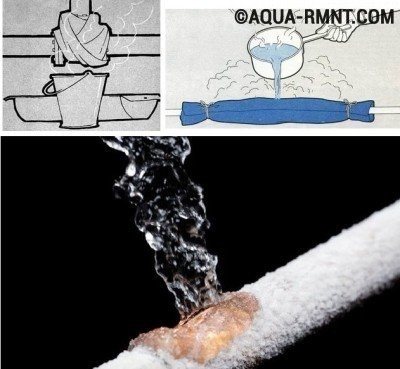

The easiest way to warm up a frozen pipe is to pour boiling water
This method is used only indoors, because if the pipe is underground, it will take a long time to warm it with boiling water - at least 12 hours.
Method 2. We use a building hair dryer
The pipe can be defrosted using hot air produced by a powerful construction hairdryer. The surface of the pipe is blown from all sides, and to reduce heat losses, it is recommended to erect a small pavilion made of polyethylene film over the frozen pipe, for example. If the pipe is plastic, you need to correctly calculate the heating so as not to melt it.
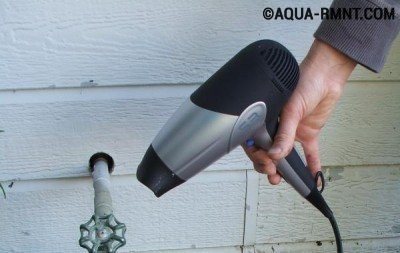

The solution to the problem of defrosting the water pipe using a conventional hair dryer, but you can also use a building
With a slight freezing of the pipe, you can use a household hair dryer or fan heater to warm it. If there are turns, constrictions, entrances to fittings, they also need to be warmed up, as ice may get stuck there. And in this case, do not forget to leave the tap open.
Method 3. Electric current comes to the rescue
How to warm up frozen water pipes using electric current?
Heating up a metal water pipe
can be produced using a welding transformer: the positive wire is connected to one end of the pipe, and the negative wire to the second. In this simple way, the problem can be solved in a few minutes: the ice plug will melt.
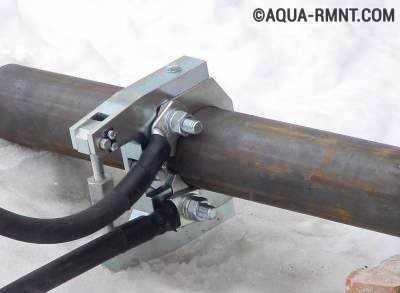

The time for warming up frozen water supply metal pipes with a welding transformer is minimal
Heating up the plastic pipeline
can be done using a two-core copper wire with a cross section of 2.5 mm. This method is similar to the principle of operation of a familiar home boiler. The wires are separated. One of them is simply bent, and the second is exposed and 3-5 turns are twisted around the wire, cutting off the excess end. The same is done with the first core, leaving 2-3 millimeters from the turns of the second core. It is necessary to pay attention that the wires do not touch, otherwise a short circuit will result. A plug is connected to the other end of the wire. The wire is pushed into the plastic pipeline and connected to the electrical network. Passing through the water, the current heats it up, and the ice begins to melt. The method is good in that only water heats up, the wires remain cold and this prevents accidental melting of the plastic pipe. To quickly blow out the melted water, you will need an additional compressor.
Method 4. We heat the pipeline with improvised means from the inside
How to warm up the water supply if it has many bends and sections? For such a case, you can build a special device. You will need a wire, a water level tube, Esmarch's medical mug (in a simple way - an enema), which consists of a rubber container with a rubber hose and a small tap for draining water. The hydraulic level tube is fastened to the wire using electrical tape so that the end of the tube is slightly longer than the wire. Push it into the water supply until it stops. Hot water flows out of the rubber tank into the pipeline. It is necessary to organize collection of melt water.
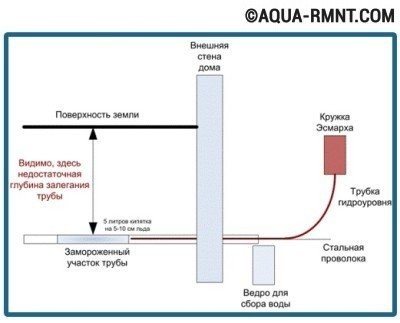

Schematic representation of the wire and enema rewarming process
As the ice thaws, the pipe with the wire is pushed further. The process of warming up a frozen water supply using improvised means is quite laborious and requires a lot of patience and time (about 1 hour per meter of frozen pipe), but the costs are minimal.
Method 5. Calling specialists
You can also warm up the water pipe from the inside with the help of special equipment - a hydrodynamic unit, the direct purpose of which is preventive flushing of water and sewer pipes.
Hot water with a temperature of 150 degrees is supplied under high pressure (90-100 atm) through the hose. The water boiler of the installation runs on diesel fuel, and the unit is powered by a power grid with a capacity of at least 7 kW and a voltage of 380V. For this method, it is necessary to call specialists, so this method is not suitable for everyone.
The main causes of freezing
There are quite a few of them, and far from all of them the tenants themselves are to blame (although the valiant communal services most often write off their sins on us). We also note that a whole complex of problems often leads to trouble, among which there are several main ones:
- Human factor (end users, home residents).
- Service provider company.
- The factor of chance.
- Decay of the heating system
Human factor
Each basement of an apartment building has special ventilation holes - air vents that are needed for ventilation. In the summer they "work" for their intended purpose, and for the winter (ie, during the heating season), they are supposed to be closed. But such "trifles" are not used by public utilities, nor by the tenants themselves - and so it will do.
As long as the temperature holds, the situation remains under control. But as soon as the frost hits, the cold penetrates into the basement and begins to actively freeze it. Ice crystals appear in the pipe, which quickly grow and completely block its lumen. If you are lucky, the integrity of the channel will not be violated, and the answer to the question of how to defrost the heating system will be found quickly enough. If you "pulled out a lucky ticket", the pipe breaks apart (do you remember that water expands when it freezes?) With all the ensuing consequences.
Service provider
It happens that the initial temperature of the coolant is below the standards. Until it "gets" to the consumer, the degree will drop even more. In this case, the remaining heat is simply not enough to resist the severe frost, and the situation will follow the standard pattern (see the previous section).
The random factor
If the air temperature in the conditionally "warm" region of the middle zone has dropped to -40 degrees, no one is to blame for this. But because of this, pipes that worked normally at -20 are unable to resist the cold and begin to freeze. If this weather lasts for several days, you can expect trouble.
Decay of the heating system
The pipe industry in many cities has not changed for decades, which is why the communications have simply worked out the resource inherent in them. Thus, a significant narrowing of the pipe diameter leads to a drop in outlet temperature, and a violation of thermal insulation leads to the appearance of ice crystals. What will follow next - you already know.
What other reasons can lead to the fact that water has frozen in the heating system (this time -0 without looking for a specific "culprit"):
- Insufficient or damaged pipe insulation
- The level of the heating main or its segment is your point of soil freezing
- Untimely drainage of water from the circuit
- Hidden problems that do not externally manifest themselves for a long time (for example, a decrease in the efficiency of heating pipes or a background leak on the highway). The last case is the most difficult, since not all communications are equipped with PU foam insulation, which helps to detect the place of a breakthrough. And to find it in winter, when the roads are covered with a meter layer of snow and ice on an area of 2-3 kilometers long, is still a "pleasure".










